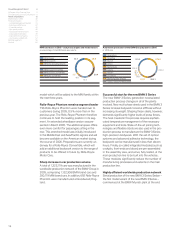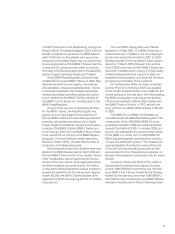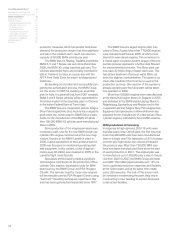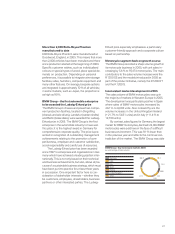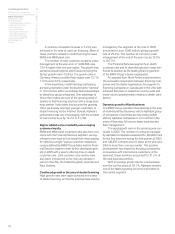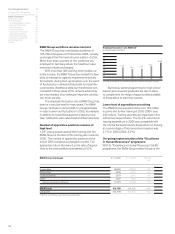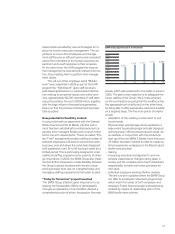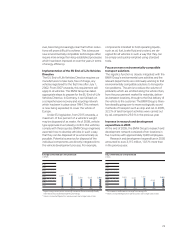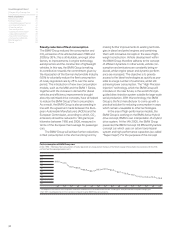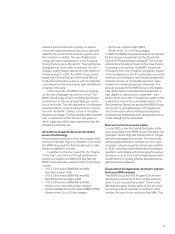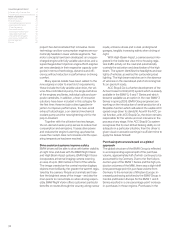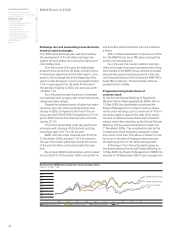BMW 2005 Annual Report Download - page 29
Download and view the complete annual report
Please find page 29 of the 2005 BMW annual report below. You can navigate through the pages in the report by either clicking on the pages listed below, or by using the keyword search tool below to find specific information within the annual report.
28
Quality and environmental management
system receives approval
All of the BMW Group locations adhere to high
standards in the areas of quality and environmental
care. This was confirmed once again in December
2005 with the successful completion of the certifi-
cation audit of the BMW Group production function.
This new certificate, which verifies that the quality
and environment management system complies with
DIN EN ISO 9001 and DIN EN ISO 14001, is valid
for the next three years. This was the second time
that the systems were certified using the so-called
“matrix process”, according to which each location
only has to be audited once within a three-year
cycle. Central production units and control func-
tions of the management system are audited annu-
ally. In 2005, the scope of the certificated area was
extended to include the BMW plant in Thailand
as well as motorcycle development and production.
The BMW Group has never before had a larger
area covered by a single certificate. Specialist exter-
nal auditors (the German TÜV organisation) not only
confirmed a very high standard in terms of quality
and environment care, but also highlighted some
processes as exemplary.
Ongoing measures to reduce emissions and
safeguard resources
A number of key indicators demonstrate the effi-
ciency of the BMW Group’s resources manage-
ment. For example, over the past five years, the
plants in Regensburg and Leipzig have been able
to reduce the amount of solvents used in the com-
pany in total by almost 33% by extending the use
of solvent-free powder varnish technology and ap-
plying a range of other methods. During the same
period of time, the volume of water wasted during
the production process was reduced by almost
29%. Despite the increase in 2005, it has been
possible over the past ten years to reduce energy
consumption by approximately 25% and CO
2
emis-
sions by 20%. These reductions were achieved
by using district heating and combined heat and
power systems, and by applying a range of innova-
tive projects such as district cooling. As an example,
the Projekthaus (Project Building) erected in 2004
as part of the BMW Group’s research and innovation
centre is cooled with groundwater from just below
the ground surface. District cooling has been used
largely to replace traditional electrically operated
cooling equipment. Each year, this avoids emissions
of up to 5,000 tonnes of CO
2
and saves around
8 million kilowatt hours of electricity, equivalent to
the energy consumption of approximately 3,000 pri-
vate households in Germany for one year.
With the emissions trading system in Europe
starting at the beginning of 2005, the BMW Group
was able to boast a close balance between ex-
pected CO2emissions at its European production
locations and emission rights allocated. It is, how-
Group Management Report 8
A Review of the Financial Year 8
The General Economic Environment 11
Review of operations 15
BMW Stock in 2005 38
Financial Analysis 41
--Internal Management System 41
--Earnings performance 42
--Financial position 45
--Net assets position 46
--Subsequent events report 49
--Value added statement 49
--Key performance figures 51
--Comments on BMW AG 52
Risk Management 56
Outlook 60
Volatile organic compounds (VOC) per unit produced
(kg/unit)
3.50
3.25
3.00
2.75
2.50
2.25
2.00
*Structural increase in 2002 due to the new method of calculation in accordance with
the Volatile Organic Compounds Regulation (31st Regulation on the Implementation
of the Federal Immission Control Act)
** Variance to reported figures from previous years due to larger basis of data
*Variance to reported figures from previous years due to larger basis of data
01
3.07
02*/**
3.23
03**
2.88
04**
2.26
05
2.07
Process effluent per manufactured car
(m3/unit)
1.10
1.05
1.00
0.95
0.90
0.85
0.80
0.75
01
1.07
02*
0.92
03*
0.98
04*
0.83
05
0.76


